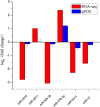Salinity stress-induced differentially expressed miRNAs and target genes in sea cucumbers Apostichopus japonicus
- PMID: 31134533
- PMCID: PMC6657415
- DOI: 10.1007/s12192-019-00996-y
Salinity stress-induced differentially expressed miRNAs and target genes in sea cucumbers Apostichopus japonicus
Abstract
Environmental salinity is an important abiotic factor influencing normal physiological functions and productive performance in the sea cucumber Apostichopus japonicus. It is therefore important to understand how changes in salinity affect sea cucumbers in the face of global climate change. In this study, we investigated the responses to salinity stress in sea cucumbers using mRNA and miRNA sequencing. The regulatory network of mRNAs and miRNAs involved in salinity stress was examined, and the metabolic pathways enriched for differentially expressed miRNAs and target mRNAs were identified. The top 20 pathways were involved in carbohydrate metabolism, fatty acid metabolism, degradation, and elongation, amino acid metabolism, genetic information processing, metabolism of cofactors and vitamins, transport and catabolism, and environmental information processing. A total of 22 miRNAs showed differential expression during salinity acclimation. The predicted 134 target genes were enriched in functions consistent with the results of gene enrichment based on transcriptome analysis. These results suggested that sea cucumbers deal with salinity stress via changes in amino acid metabolism, ion channels, transporters, and aquaporins, under stimulation by environmental signals, and that this process requires energy from carbohydrate and fatty acid metabolism. Salinity challenge also induced miRNA expression. These results provide a valuable genomic resource that extends our understanding of the unique biological characteristics of this economically important species under conditions of salinity stress.
Keywords: Apostichopus japonicus; Different expression miRNA; Differentially expressed genes; Salinity stress; mRNA and miRNA interaction.
Conflict of interest statement
The authors declare that they have no conflict of interest.
Figures




Similar articles
-
miR-10 involved in salinity-induced stress responses and targets TBC1D5 in the sea cucumber, Apostichopus japonicas.Comp Biochem Physiol B Biochem Mol Biol. 2020 Apr;242:110406. doi: 10.1016/j.cbpb.2019.110406. Epub 2020 Jan 2. Comp Biochem Physiol B Biochem Mol Biol. 2020. PMID: 31904427
-
Understanding microRNAs regulation in heat shock response in the sea cucumber Apostichopus japonicus.Fish Shellfish Immunol. 2018 Oct;81:214-220. doi: 10.1016/j.fsi.2018.07.034. Epub 2018 Jul 17. Fish Shellfish Immunol. 2018. PMID: 30016683
-
Novel lncRNA lncRNA001074 participates in the low salinity-induced response in the sea cucumber Apostichopus japonicus by targeting the let-7/NKAα axis.Cell Stress Chaperones. 2021 Sep;26(5):785-798. doi: 10.1007/s12192-021-01207-3. Epub 2021 Jul 21. Cell Stress Chaperones. 2021. PMID: 34291427 Free PMC article.
-
Differential gene expression in the intestine of sea cucumber (Apostichopus japonicus) under low and high salinity conditions.Comp Biochem Physiol Part D Genomics Proteomics. 2018 Mar;25:34-41. doi: 10.1016/j.cbd.2017.11.001. Epub 2017 Nov 4. Comp Biochem Physiol Part D Genomics Proteomics. 2018. PMID: 29145027
-
Transcriptome analysis provides insights into the molecular mechanisms responsible for evisceration behavior in the sea cucumber Apostichopus japonicus.Comp Biochem Physiol Part D Genomics Proteomics. 2019 Jun;30:143-157. doi: 10.1016/j.cbd.2019.02.008. Epub 2019 Feb 27. Comp Biochem Physiol Part D Genomics Proteomics. 2019. PMID: 30851504
Cited by
-
lncRNA-miRNA-mRNA network in kidney transcriptome of Labeo rohita under hypersaline environment.Sci Data. 2024 Feb 22;11(1):226. doi: 10.1038/s41597-024-03056-y. Sci Data. 2024. PMID: 38388642 Free PMC article.
-
Integrated small RNA and Degradome sequencing provide insights into salt tolerance in sesame (Sesamum indicum L.).BMC Genomics. 2020 Jul 18;21(1):494. doi: 10.1186/s12864-020-06913-3. BMC Genomics. 2020. PMID: 32682396 Free PMC article.
-
Comprehensive Analysis of Whole-Transcriptome Profiles in Response to Acute Hypersaline Challenge in Chinese Razor Clam Sinonovacula constricta.Biology (Basel). 2023 Jan 10;12(1):106. doi: 10.3390/biology12010106. Biology (Basel). 2023. PMID: 36671800 Free PMC article.
-
Identification and functional characterization of a novel TRPA1 gene from sea cucumber Apostichopus japonicus and interaction with miR-2013 in response to salt stress.Cell Stress Chaperones. 2023 Nov;28(6):1027-1039. doi: 10.1007/s12192-023-01398-x. Epub 2023 Dec 18. Cell Stress Chaperones. 2023. PMID: 38108989 Free PMC article.
-
Interplay of gene expression and regulators under salinity stress in gill of Labeo rohita.BMC Genomics. 2023 Jun 19;24(1):336. doi: 10.1186/s12864-023-09426-x. BMC Genomics. 2023. PMID: 37337199 Free PMC article.
References
-
- Asha PS, Muthiah P. Effects of temperature, salinity and pH on larval growth, survival and development of the sea cucumber Holothuria spinifera Theel. Aquaculture. 2005;250(3–4):823–829.
-
- Berger VJ, Kharazova AD. Mechanisms of salinity adaptations in marine molluscs. In interactions and adaptation strategies of marine organisms. Dordrecht: Springer; 1997. pp. 115–126.
-
- Beyenbach KW, Wieczorek H. The V-type H+ ATPase: molecular structure and function, physiological roles and regulation. J Exp Biol. 2006;209(4):577–589. - PubMed
-
- Bradbury MW. Lipid metabolism and liver inflammation. I Hepatic fatty acid uptake: possible role in steatosis. Am J Physiol-Gastr L. 2006;290(2):194–198. - PubMed
-
- Breves JP, Fox BK, Pierce AL, Hirano T, Grau EG. Gene expression of growth hormone family and glucocorticoid receptors, osmosensors, and ion transporters in the gill during seawater acclimation of Mozambique tilapia, Oreochromis mossambicus. J Exp Zool A. 2010;313(7):432–441. - PubMed
Publication types
MeSH terms
Substances
LinkOut - more resources
Full Text Sources
Miscellaneous

